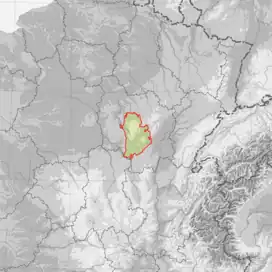Morvan
The Morvan (French pronunciation: [mɔʁvɑ̃]; historically Morvand from the Latin Murvinnum c. 590)[1] is a mountainous massif lying just to the west of the Côte d'Or escarpment in the Bourgogne-Franche-Comté region, central-east France. It is a northerly extension of the Massif Central and is of Variscan age. It is composed of granites and basalts and formed a promontory extending northwards into the Jurassic sea.
| Morvan | |
|---|---|
.jpg.webp) A view of Mount Beuvray in the Morvan area, which marks the border between the Nièvre and Saône-et-Loire departments | |
| Highest point | |
| Peak | Haut-Folin |
| Elevation | 901 m (2,956 ft) |
| Geography | |
 Area covered by the range
| |
| Country | France |
| Region | Bourgogne-Franche-Comté |
| Borders on | Massif Central |
It is the smallest mountain area in France in terms of landmass covered, as well as the lowest, with a maximum altitude of 901 metres (2,956 feet) at Haut-Folin.
Geography
The Morvan is located across the Côte-d'Or, Nièvre, Saône-et-Loire and Yonne departments in the Bourgogne-Franche-Comté region in central-east France.
At its heart nowadays is the protected area of Morvan Regional Natural Park (French: Parc naturel régional du Morvan).
Its main town is Château-Chinon, Nièvre on the D978 road between Nevers and Autun. Several of its valleys have been dammed to form reservoirs.
.svg.png.webp) Map of the cantons of the Morvan
Map of the cantons of the Morvan Map of the communes of the Morvan Regional Natural Park
Map of the communes of the Morvan Regional Natural Park Geological map of the Morvan
Geological map of the Morvan.JPG.webp) Typical landscape in the Morvan
Typical landscape in the Morvan
Music
The Morvan has a strong musical tradition. It uses musical ideas from many other cultures and combines them to make its own.
References
- Pierre-Henri Billy, Dictionnaire des noms de lieux de la France, éditions Errance, 640 pages, 2011 ISBN 978-2-87772-449-4, p. 389
External links
Internationally, Morvan is relatively unknown, so most information is in French.
- Lormes.net, a place in the Morvan (in English)
- Description of The Morvan (in French)
- Parc du morvan and pollution sources (in French)
- Le Morvan (in French)